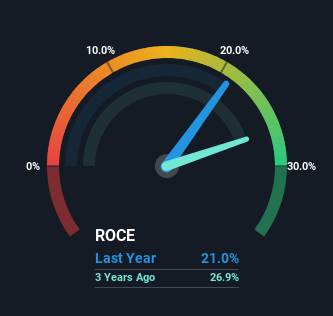Investors Could Be Concerned With South Port New Zealand's (NZSE:SPN) Returns On Capital
There are a few key trends to look for if we want to identify the next multi-bagger. Ideally, a business will show two trends; firstly a growing return on capital employed (ROCE) and secondly, an increasing amount of capital employed. If you see this, it typically means it's a company with a great business model and plenty of profitable reinvestment opportunities. Looking at South Port New Zealand (NZSE:SPN), it does have a high ROCE right now, but lets see how returns are trending.
Return On Capital Employed (ROCE): What Is It?
If you haven't worked with ROCE before, it measures the 'return' (pre-tax profit) a company generates from capital employed in its business. To calculate this metric for South Port New Zealand, this is the formula:
Return on Capital Employed = Earnings Before Interest and Tax (EBIT) ÷ (Total Assets - Current Liabilities)
0.21 = NZ$18m ÷ (NZ$98m - NZ$13m) (Based on the trailing twelve months to June 2023).
Thus, South Port New Zealand has an ROCE of 21%. That's a fantastic return and not only that, it outpaces the average of 3.8% earned by companies in a similar industry.
Check out our latest analysis for South Port New Zealand

While the past is not representative of the future, it can be helpful to know how a company has performed historically, which is why we have this chart above. If you want to delve into the historical earnings, revenue and cash flow of South Port New Zealand, check out these free graphs here.
So How Is South Port New Zealand's ROCE Trending?
On the surface, the trend of ROCE at South Port New Zealand doesn't inspire confidence. While it's comforting that the ROCE is high, five years ago it was 29%. However, given capital employed and revenue have both increased it appears that the business is currently pursuing growth, at the consequence of short term returns. If these investments prove successful, this can bode very well for long term stock performance.
In Conclusion...
In summary, despite lower returns in the short term, we're encouraged to see that South Port New Zealand is reinvesting for growth and has higher sales as a result. These trends are starting to be recognized by investors since the stock has delivered a 35% gain to shareholders who've held over the last five years. So this stock may still be an appealing investment opportunity, if other fundamentals prove to be sound.
On a separate note, we've found 2 warning signs for South Port New Zealand you'll probably want to know about.
South Port New Zealand is not the only stock earning high returns. If you'd like to see more, check out our free list of companies earning high returns on equity with solid fundamentals.
Have feedback on this article? Concerned about the content? Get in touch with us directly. Alternatively, email editorial-team (at) simplywallst.com.
This article by Simply Wall St is general in nature. We provide commentary based on historical data and analyst forecasts only using an unbiased methodology and our articles are not intended to be financial advice. It does not constitute a recommendation to buy or sell any stock, and does not take account of your objectives, or your financial situation. We aim to bring you long-term focused analysis driven by fundamental data. Note that our analysis may not factor in the latest price-sensitive company announcements or qualitative material. Simply Wall St has no position in any stocks mentioned.

 Yahoo Finance
Yahoo Finance 